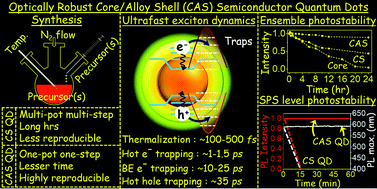Ultrafast dynamics and ultrasensitive single particle spectroscopy of optically robust core/alloy shell semiconductor quantum dots
Abstract
A “one-pot one-step” synthesis method of Core/Alloy Shell (CAS) quantum dots (QDs) offers the scope of large scale synthesis in a less time consuming, more economical, highly reproducible and high-throughput manner in comparison to “multi-pot multi-step” synthesis for Core/Shell (CS) QDs. Rapid initial nucleation, and smooth & uniform shell growth lead to the formation of a compositionally-gradient alloyed hetero-structure with very significantly reduced interfacial trap density in CAS QDs. Thus, interfacial strain gets reduced in a much smoother manner leading to enhanced confinement for the photo-generated charge carriers in CAS QDs. Convincing proof of alloy-shelling for a CAS QD has been provided from HRTEM images at the single particle level. The band gap could be tuned as a function of composition, temperature, reactivity difference of precursors, etc. and a high PLQY and improved photochemical stability could be achieved for a small sized CAS QD. From the ultrafast exciton dynamics in CdSe and InP CAS QDs, it has been shown that (a) the hot exciton thermalization/relaxation happens in <500 fs, (b) hot electron trapping dynamics occurs within a ∼1 ps time scale, (c) band edge exciton trapping occurs within a 10–25 ps timescale and (d) for CdSe CAS QDs the hot hole gets trapped in about 35 ps. From fast PL decay dynamics, it has been shown that the amplitude of the intermediate time constant can be correlated with the PLQY. A model has been provided to understand these ultrafast to fast exciton dynamical processes. At the ultrasensitive single particle level, unlike CS QDs, CdSe CAS QDs have been shown to exhibit (a) constancy of PLmax (i.e. no bluing) and (b) constancy of PL intensity (i.e. no bleaching) of the single CAS QDs for continuous irradiation for one hour under an air atmosphere. Thus, CAS QDs hold the promise of being a superior optical probe in comparison to CS QDs both at the ensemble and at the single particle level, leading to enhanced flexibility of the CAS QDs towards designing and developing next generation application devices.

- This article is part of the themed collection: PCCP Reviews


 Please wait while we load your content...
Please wait while we load your content...